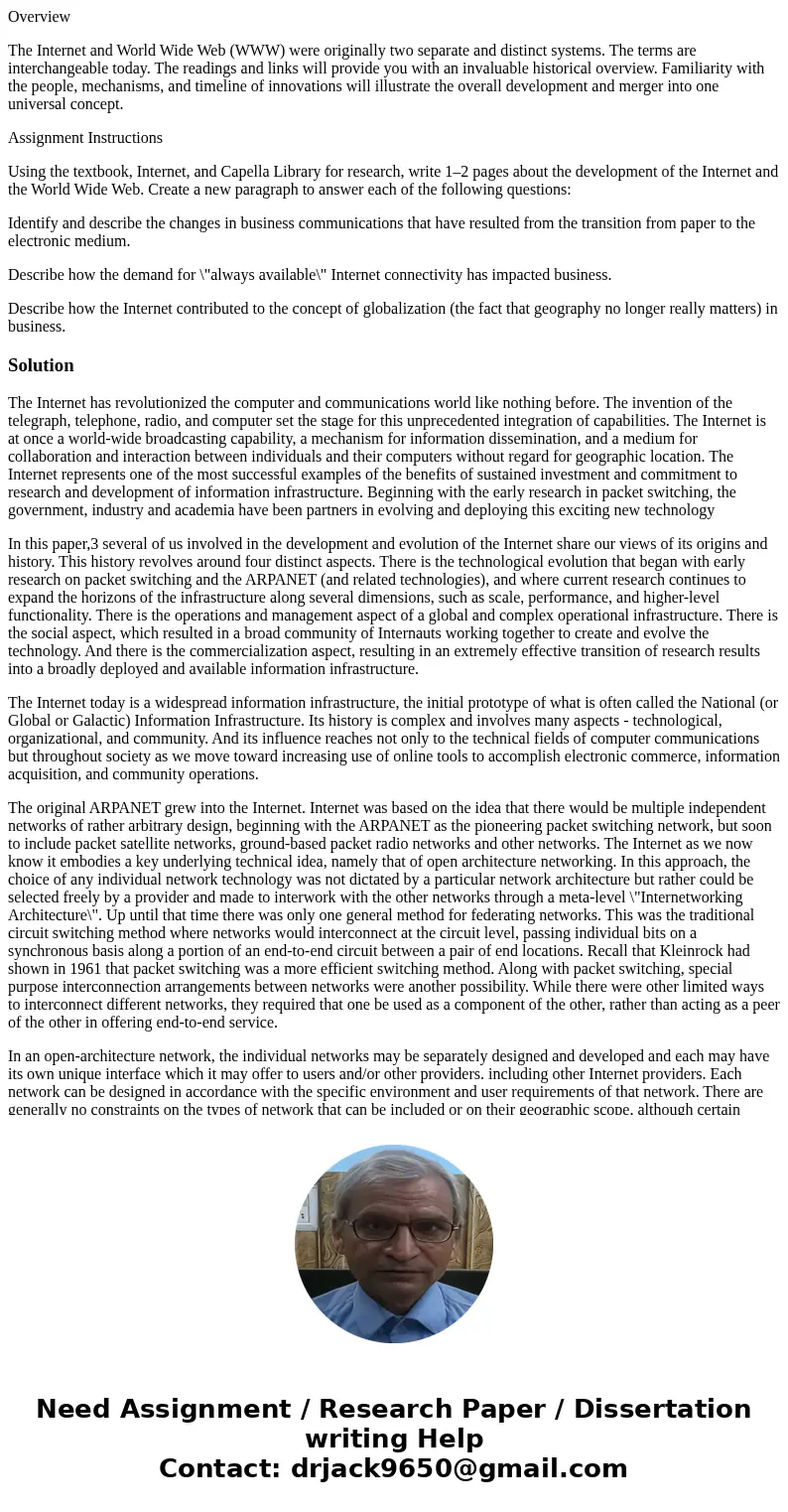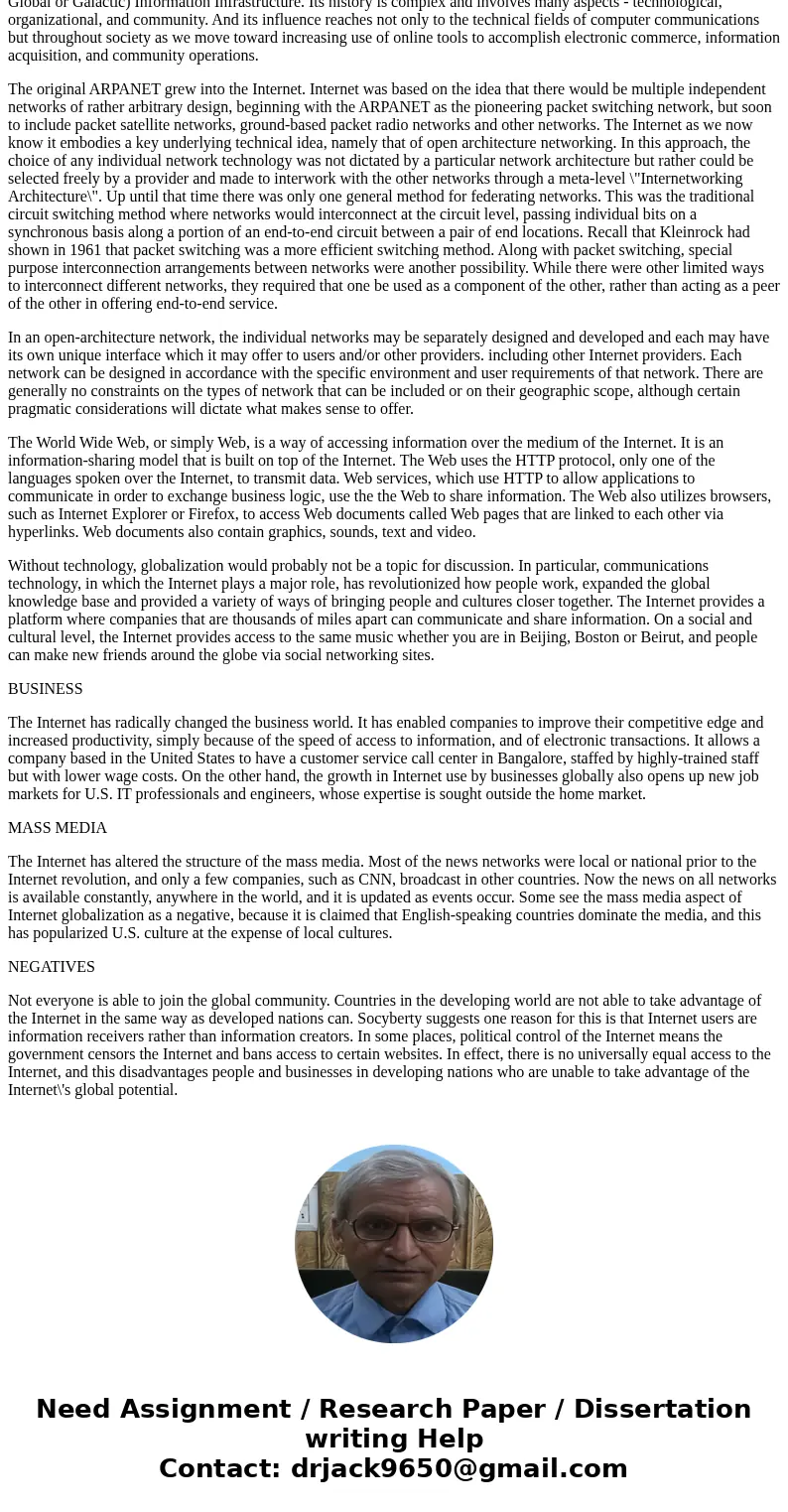Overview The Internet and World Wide Web WWW were originally
Overview
The Internet and World Wide Web (WWW) were originally two separate and distinct systems. The terms are interchangeable today. The readings and links will provide you with an invaluable historical overview. Familiarity with the people, mechanisms, and timeline of innovations will illustrate the overall development and merger into one universal concept.
Assignment Instructions
Using the textbook, Internet, and Capella Library for research, write 1–2 pages about the development of the Internet and the World Wide Web. Create a new paragraph to answer each of the following questions:
Identify and describe the changes in business communications that have resulted from the transition from paper to the electronic medium.
Describe how the demand for \"always available\" Internet connectivity has impacted business.
Describe how the Internet contributed to the concept of globalization (the fact that geography no longer really matters) in business.
Solution
The Internet has revolutionized the computer and communications world like nothing before. The invention of the telegraph, telephone, radio, and computer set the stage for this unprecedented integration of capabilities. The Internet is at once a world-wide broadcasting capability, a mechanism for information dissemination, and a medium for collaboration and interaction between individuals and their computers without regard for geographic location. The Internet represents one of the most successful examples of the benefits of sustained investment and commitment to research and development of information infrastructure. Beginning with the early research in packet switching, the government, industry and academia have been partners in evolving and deploying this exciting new technology
In this paper,3 several of us involved in the development and evolution of the Internet share our views of its origins and history. This history revolves around four distinct aspects. There is the technological evolution that began with early research on packet switching and the ARPANET (and related technologies), and where current research continues to expand the horizons of the infrastructure along several dimensions, such as scale, performance, and higher-level functionality. There is the operations and management aspect of a global and complex operational infrastructure. There is the social aspect, which resulted in a broad community of Internauts working together to create and evolve the technology. And there is the commercialization aspect, resulting in an extremely effective transition of research results into a broadly deployed and available information infrastructure.
The Internet today is a widespread information infrastructure, the initial prototype of what is often called the National (or Global or Galactic) Information Infrastructure. Its history is complex and involves many aspects - technological, organizational, and community. And its influence reaches not only to the technical fields of computer communications but throughout society as we move toward increasing use of online tools to accomplish electronic commerce, information acquisition, and community operations.
The original ARPANET grew into the Internet. Internet was based on the idea that there would be multiple independent networks of rather arbitrary design, beginning with the ARPANET as the pioneering packet switching network, but soon to include packet satellite networks, ground-based packet radio networks and other networks. The Internet as we now know it embodies a key underlying technical idea, namely that of open architecture networking. In this approach, the choice of any individual network technology was not dictated by a particular network architecture but rather could be selected freely by a provider and made to interwork with the other networks through a meta-level \"Internetworking Architecture\". Up until that time there was only one general method for federating networks. This was the traditional circuit switching method where networks would interconnect at the circuit level, passing individual bits on a synchronous basis along a portion of an end-to-end circuit between a pair of end locations. Recall that Kleinrock had shown in 1961 that packet switching was a more efficient switching method. Along with packet switching, special purpose interconnection arrangements between networks were another possibility. While there were other limited ways to interconnect different networks, they required that one be used as a component of the other, rather than acting as a peer of the other in offering end-to-end service.
In an open-architecture network, the individual networks may be separately designed and developed and each may have its own unique interface which it may offer to users and/or other providers. including other Internet providers. Each network can be designed in accordance with the specific environment and user requirements of that network. There are generally no constraints on the types of network that can be included or on their geographic scope, although certain pragmatic considerations will dictate what makes sense to offer.
The World Wide Web, or simply Web, is a way of accessing information over the medium of the Internet. It is an information-sharing model that is built on top of the Internet. The Web uses the HTTP protocol, only one of the languages spoken over the Internet, to transmit data. Web services, which use HTTP to allow applications to communicate in order to exchange business logic, use the the Web to share information. The Web also utilizes browsers, such as Internet Explorer or Firefox, to access Web documents called Web pages that are linked to each other via hyperlinks. Web documents also contain graphics, sounds, text and video.
Without technology, globalization would probably not be a topic for discussion. In particular, communications technology, in which the Internet plays a major role, has revolutionized how people work, expanded the global knowledge base and provided a variety of ways of bringing people and cultures closer together. The Internet provides a platform where companies that are thousands of miles apart can communicate and share information. On a social and cultural level, the Internet provides access to the same music whether you are in Beijing, Boston or Beirut, and people can make new friends around the globe via social networking sites.
BUSINESS
The Internet has radically changed the business world. It has enabled companies to improve their competitive edge and increased productivity, simply because of the speed of access to information, and of electronic transactions. It allows a company based in the United States to have a customer service call center in Bangalore, staffed by highly-trained staff but with lower wage costs. On the other hand, the growth in Internet use by businesses globally also opens up new job markets for U.S. IT professionals and engineers, whose expertise is sought outside the home market.
MASS MEDIA
The Internet has altered the structure of the mass media. Most of the news networks were local or national prior to the Internet revolution, and only a few companies, such as CNN, broadcast in other countries. Now the news on all networks is available constantly, anywhere in the world, and it is updated as events occur. Some see the mass media aspect of Internet globalization as a negative, because it is claimed that English-speaking countries dominate the media, and this has popularized U.S. culture at the expense of local cultures.
NEGATIVES
Not everyone is able to join the global community. Countries in the developing world are not able to take advantage of the Internet in the same way as developed nations can. Socyberty suggests one reason for this is that Internet users are information receivers rather than information creators. In some places, political control of the Internet means the government censors the Internet and bans access to certain websites. In effect, there is no universally equal access to the Internet, and this disadvantages people and businesses in developing nations who are unable to take advantage of the Internet\'s global potential.


 Homework Sourse
Homework Sourse